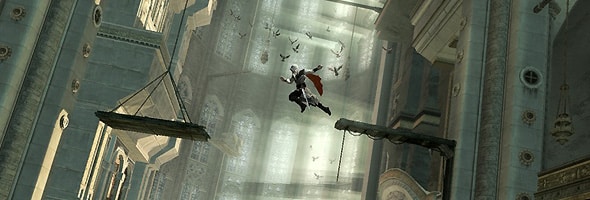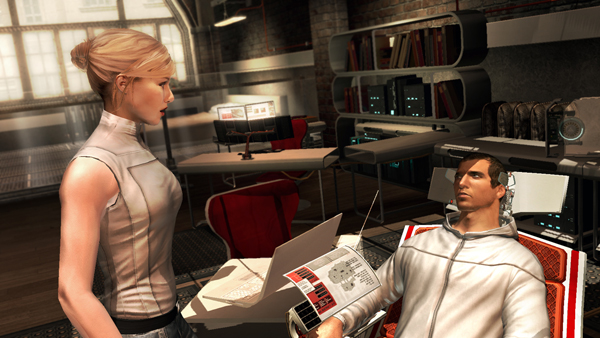A cut above the rest?
In his seminal masterpiece “The Civilisation of the Renaissance in Italy”, 19th Century historian Jacob Burckhardt says of that time period:
“An objective treatment and consideration of the state and of all the things of this world became possible.The subjective side...asserted itself with corresponding emphasis; man became a spiritual individual and recognised himself as such.”
 The reader can see much of this Renaissance Representation reflected in Ubisoft’s Assassin’s Creed II - here we have characters critiquing the state, putting forward their own plans, propositions. At the same time, the game exhibits the flamboyant showmanship of the Renaissance through festivals, carnivale, extravagant clothing, architecture and art.
The reader can see much of this Renaissance Representation reflected in Ubisoft’s Assassin’s Creed II - here we have characters critiquing the state, putting forward their own plans, propositions. At the same time, the game exhibits the flamboyant showmanship of the Renaissance through festivals, carnivale, extravagant clothing, architecture and art.
There is, however, one key difference between Burkhardt’s work and Ubisoft’s game - Assassin’s Creed II is actually quite a bit of fun, whereas Civilisation makes me want to stick a hidden blade in my brain via nostril.
That said, the game deserves more than just to be labeled ‘a bit of fun’. Actually, bluntly put, ACII makes the original 'Creed look like a blueprint for this sequel. In fact, I’m going to lay my terribly orthodox opinions down on the table and proclaim Assassin’s Creed II as the best the franchise has offered to date.
Everything you can do...
At a first glance, this may seem a bold claim. Although it’s true that ACII might briefly look much like the same action-conspiracy-laden-sandbox-parkour-stabfest-adventure as before, now just a bit dressed up to fit the 15thC, the lightest of scrapings reveals just how much the developers have responded to criticism of the original game. Actually, it’s pretty much impossible to discuss the game without frequently referring to the first game’s inadequacies - every element of the original has been somehow tweaked, improved, re-thought or else redacted for the sequel.
This list of improvements, while not actually endless, certainly comes out longer than the dialogue in your average Michael Bay flick. ACI’s singular, bland enemy type has been flattened under the variety of enemies endowed with a superfluity of weapons - daggers, hammers, axes, spears. Fists are now a viable option in combat. The unwavering sun that one shone on Damascus and Jerusalem has been switched for a timed day/night cycle.
Ezio, the game’s new protagonist, is both nimble and acrobatic (and makes his predecessor Altair look positively arthritic). This, among other things, entails he doesn’t have to be on a level plane with his target to exact swift murdery goodness. Nope: The player can now dispatch his target from rooftops, ledges, even while napping in a stray bale of hay.
This is a game that wants you to enjoy yourself right up to the end of the 20 hours or so of story, while AC1 was the equivalent of a blind date that keeps yawning and checking her watch, wondering when you’re going to pluck up the nerve to excuse yourself and leave.
Alright, I hear you: less social life, more escapism.
Where there’s an alteration, there’s an addition - too many to fully list, though one of the standout inclusions that can't be overlooked are the ‘Assassin’s Tomb’ missions: six entirely optional, linear levels that vary from sewer to palace, and require the player to exercise as much mental agility as dexterity. I say optional, you’d be a fool to overlook them.
 |
| Tomb With a View? |
Never Cross the Streams (unless developing games)
These alterations and add-ons are all well and good, and make for a much more enjoyable romp. Assassin’s Creed II’s highpoint (pun!), though, isn’t in these micro-improvements; rather it's in the way all these individual elements (let’s for convenience’s sake categorise them into setting, narrative and gameplay) are woven together, not tacked alongside each other.
‘Nay!’ cries the objector. ‘Surely gameplay always has a place in the narrative of a games, and that story always has to be set within a place? What makes this game so special?’ True, uncommonly literate respondent - almost all games will connect story, place and gameplay together to some extent. Some, however do it better than others, and some are as accomplished at it as I am at football.
(My career at that particular sport slid from defender to goalkeeper to goalpost, in case you’re wondering).
Particular examples of games that flail at this element merging are Tony Hawk’s Pro Skater (I can’t believe those pesky COMBO letters have escaped again!); Call of Duty (“Why is the player suddenly in this location?” “Why not? It looks pretty”), and, of course, the original Assassin’s Creed, where missions were unashamedly added on after the narrative was already finished.
Conversely, in Assassin’s Creed II, narrative, setting and gameplay are coiled into a single whole to such a degree that it would be impossible to parse them apart.
Bear with me - it's necessary to explain this bit properly.
Take narrative and setting alone, first of all. Interesting historical characters, from the dubious Pazzi to the downright nasty Borgia, as well as the surprisingly comic Da Vinci himself, have central parts to play within the plot. Staples of the Renaissance - religion, conspiracy, self-expression - also happen to be themes that bleed into the Assassin’s series as a whole.
It would, then, be jarring to uproot the plot and plant it in a different place or time period - they're too bound together, which is just as well, because Renaissance Italy sprawls in both of the game’s halves: Florence, Tuscany and Forli, then in the larger labyrinthine Venice (or Venezia, if you want to sound pretentious and make people dislike you more). Real architectural landmarks are realised, when viewed up close with startling detail. I’m not going to say ‘living breathing world’, but It’s a close run thing. Costumes are extravagant, cities bustle with noise and music.
 |
| Changes are justified from a narrative standpoint, deepening immersion |
These elements of setting and plot then built into the gameplay, not alongside. Missions, to different extents, always have some kind of relevance to the narrative, very rarely existing as obvious time-padding. The ‘Hey Altair, please find my flags and I’ll tell you something about your target’ structure of AC1 is no more; rather, cutscenes and dialogue always frame the basis for what the player does. The gameplay changes noted above, additionally, are justified narratively by the fact that the ever bland Desmond is hooked up to the Animus 2.0. It's another unnecessary yet welcome touch that adds another piece of evidence to the overallpoint.
The developers also use gameplay to emphasise certain points of narrative. To make another bad pun, the merging cuts both ways. Ezio’s first intended assassination, for example. is both emotion-fuelled and sloppy, and forces him to flee his home town and take refuge in his uncle's mansion. The game recognises the player's rustiness and uses it, making the player feels as though his/her actions are in tune with the narrative, not distinct. Desmond’s shorter sequences similarly grow clumsy combat to honed carnage as comes to absorb the skills of his ancestors as the player's skill progresses alongside.
Needles in a Haystack
 It’s this coalescing that was the downfall of the original Assassin’s Creed, but what makes this sequel shine even when the graphics begin to look less than sparkling - which is just as well, because that’s happening as the next generation begins to roll in. The animations that only a few years ago were at worst adequate have become comical.
It’s this coalescing that was the downfall of the original Assassin’s Creed, but what makes this sequel shine even when the graphics begin to look less than sparkling - which is just as well, because that’s happening as the next generation begins to roll in. The animations that only a few years ago were at worst adequate have become comical.
Don’t believe me? Fast forward to the ‘grueling’ scene of 5:50-6:00 of this walkthrough (disclaimer, which isn’t owned by me) and see for yourself. Can you not taste the horror of the scene? Me neither
It’s not just in the close-up detail that the game fumbles a bit, either. The grand buildings, as noted, look sublime when being climbed but from a distance look more like cardboard cut-outs than imposing structures. The skyline overall also looks muddied and hazy compared with more recent gaming cityscapes.
The narrative also suffers from a few blights, the main foible being that story often juts forward years at a time, leaving the player perplexed and often disgruntled. Characters are often disposed of in odd ways, too - Ezio effectively damns his sister to several decades of managing his finances.
It’s important to realise, however, that most of these flaws arise only because ACII bites off considerably more than ACI ever attempted to chew. These shortcomings, in other words, exist because the game tries to do much more with itself and sets the standard far higher. The vast majority of the time, it succeeds.
Overall, ACII is still a fantastic, incredible, adjectival-topping jaunt into one of the best games that the current generation has to offer. Even when the game becomes as old as Burkhardt’s language, it’ll never be as archaic.
But why bother waiting that long at all? Get climbing, get running, get stabbing. Go.
If you want to see my opinion of Assassin's Creed the first, go here.
To read about my adventures an an uneducated juvenile, go here.
If you want to read Jacob Burckhardt, go get some sun.
To read about my adventures an an uneducated juvenile, go here.
If you want to read Jacob Burckhardt, go get some sun.





